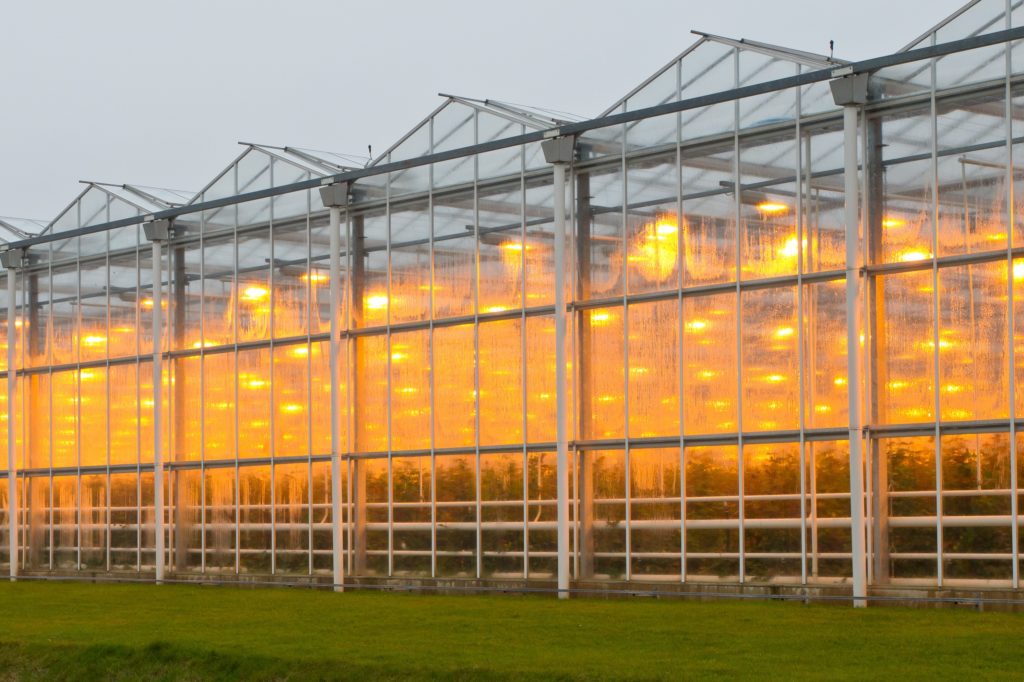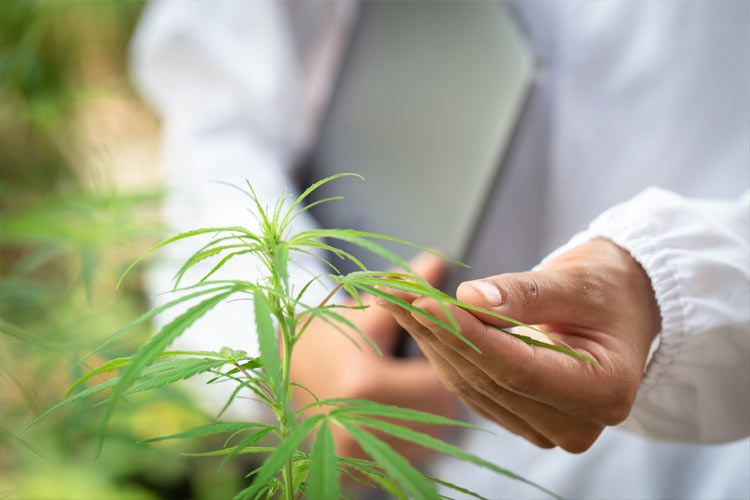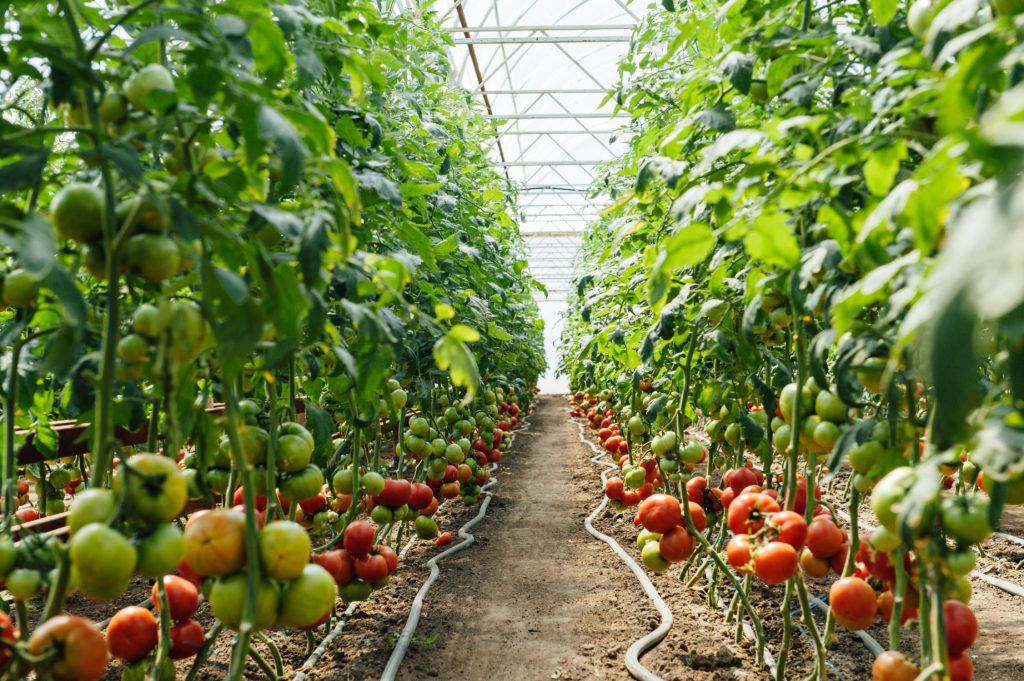The market for air treatment and active dehumidification of greenhouses
Applications

Large heated
greenhouses
Heated greenhouses of one hectare or more are often used for market gardening.
Tomato, cucumber and pepper are the most frequent crops. These plants are tall, they occupy a large part of greenhouse’s volume. The foliage is extended with a high leaf area generating strong evapotranspiration.
Many farmers grow above ground on gutters and some producers have chosen to have aeraulic ducts in the space under gutters.
The AirGaïa solution has the advantage of being ideally implanted in these greenhouses by blowing under the crop in ducts.
In the case of semi-enclosed greenhouses, compact indoor units can easily be placed in the corridor.
With our system, as the greenhouse is heated, care must be taken to retain as much heat as possible, so the greenhouse must stay closed.
This will also conserve CO2.
Finally, the blowing temperature must remain close enough to the temperature of the greenhouse so as not to disturb the crop.

Medicinal
Cannabis
In isolated closed premises (“indoor”), the cultivated areas are cells sized about 100m² while in greenhouses, the culture is more often divided into independent areas of about 500m².
This crop evapo-transpire strongly and is extremely demanding in terms of thermal and hygrometric stability. Choosing an active dehumidification system is not an option : it is necessary to dehumidify intensely all year round.
Artificial lighting or the greenhouse effect generate strong heat release. Since the plant is sensitive to excess temperature, the dehumidification process must operate without any additional heat input.
Blowing temperatures must be controlled and amplitudes must be low so as not to affect the health and growth of the plant.
Overall, it is essential to guarantee a very stable climate in order to obtain optimum quality, especially in the concentration of pharmaceutically active substances.
This crop is also very energy intensive: high set temperatures; strong dehumidification needs; indoor artificial lighting combined with cooling. It is therefore wise to use an energy-efficient system.
Air treatment equipment is essential for cannabis cultivation but its implementation must not be at the expense of the cultivated area.
AirGaïa provides a specific response to the specific needs of each project.

Organic greenhouse
farming
These greenhouses belong to the category of “cold frame greenhouses”.
In organic farming, the control of air quality is even more important than in heated greenhouses of the same crop.
To meet the Organic Label, French regulations specify that:
- If the greenhouse is heated, then the sale at the production stage with organic label for the following vegetables: tomatoes, zucchini, peppers, eggplants and cucumbers is prohibited from December 21st to April 30th.
- Producers can only use renewable energy to heat greenhouses, for all farms running organic conversion since 1st January 2020. For farms in conversion or certified before that date, this obligation will come into effect from 1st January 2025.
- These obligations do not apply to the production of seedlings
These regulations can be met with The AirGaïa system :
- The dehumidification mode can be used all year round,
- The heating mode by heat pump and therefore by renewable energy can be activated outside the 4 prohibited months.
Market expectations
Greenhouse growers who have thermal and aeraulic requirements:
- Keep the greenhouse closed for as long as possible
- Have sufficient dehumidification power
- Blow air at the right temperature for cultivation (neither too hot nor too cold)
- Do not cool down the greenhouse in winter and do not heat up it in summer
- Do not blow directly into the foliage
- Cap fan consumption
- Allow temperatures and humidity homogeneity at any position in the greenhouse with the right vertical temperature gradient
- Avoid hot spots and cold spots.
Implementation issues :
- Setting up in the greenhouse without generating a drop shadow
- fitting in the greenhouse without cutting back on the growing space
- fitting without penalizing people workflow in the greenhouse.
AirGaïa’s Dehumidification solution perfectly meets these needs:
________________________________________________________________________ Other solutions on the market
Controlled Ventilation Systems
These systems are based on the principle of dehumidification by heating/aeration with the entry of cold outside air, the use of heating to bring hot and humid air out of the greenhouse through the openings on the roof.
The difference is that the air inlet is controlled with just the necessary airflow blown in: either by dedicated fans, or via a mixing area called corridor in semi-closed greenhouses.
A variation of this system uses a double-flow exchanger to pre-heat the blown outside air using the heat of the air extracted from the greenhouse
Pros:
- High dehumidification power when the outside air is cold
- Limited heat loss with dual-flow option
- Allows to place the greenhouse in light overpressure and avoid uncontrolled air intakes
- Energy saving estimated at 15% according to the CTIFL.
Cons:
- Cold outdoor air cools down the greenhouse by replacing the warm indoor air that is discharged outside. There is always a loss of heat through the openings and a waste of energy.
- Lack of efficiency when the Indoor/Outdoor temperature difference is low
- Lack of efficiency on temperate and wet days
- Lack of efficiency for cold frame greenhouses (about 10 / 12°C)
- For greenhouses enriched with injected CO2, opening the roof openings
causes the CO2 losses. This leads to a decrease in CO2 concentration and consequently in the growth yield of the crop, or the need to inject more CO2 with an increase in the operating cost when this CO2 is purchased and not recovered on site during the combustion of natural gas.
The entry of outside air and the opening of roof can cause insects or diseases entering
Maximum Air flow from 4000 to 5000m3/h resulting in a limited or insufficient air renewal rate.
Thermodynamic dehumidifiers
These systems are active dehumidifiers.
They include a thermodynamic group composed of a fan, a compressor, a cold exchanger called evaporator coil (which is used to produce cold) and a hot exchanger called condenser coil (which produces heat).
The fan circulates the air from the greenhouse through the evaporator battery where the air is cooled and whose water vapor condenses and is collected and evacuated.
The cooled and dehumidified air then circulates through the condenser battery where it is heated before being blown hot and dry into the greenhouse.
Advantages:
- The greenhouse is kept closed: no cold outdoor air inlet potentially including insects or diseases
- The greenhouse is kept closed: no loss of CO2, financial loss when CO2 is purchased and preservation of a high CO2 concentration favoring the growth of the crop
- The dehumidifier has a positive overall energy balance and in winter this will allow the greenhouse to heat with a ratio of 2 to 3kWh heat produced for 1kWh electric consumed, according to the heat pump principle.
- Heating energy savings are estimated to 15% according to the CTIFL.
Disadvantages:
- When there is a need to dehumidify during summer and mid-season, the system heats the greenhouse (about 20kW hot per 1000m²) instead of limiting its rise in temperature
- Blowing temperature too hot for some crops: nearly 10°C above greenhouse temperature
- Air flow rate from 3000 to 5000m3/h resulting in a limited or insufficient air mixing rate.
- So far, there is no suitable model to blow into a duct and thus facilitate its integration in the case of off-ground cultivation where the foliage occupies the entire volume (tomatoes, cucumbers, peppers …)
- To date, there is no suitable model to fit into a semi-enclosed greenhouse corridor.
Hygroscopic dehumidifiers
These systems are active dehumidifiers. They remove humidity from the air using a desiccant solution that absorbs and retains water from the air.
The air is blown so that it passes through a honeycomb curtain fed by a saline solution of lithium chloride for example. Passing through, it loses its humidity.
The saline solution then loaded with water must be regenerated before it can capture any more water again. This regeneration is done continuously by heating via an exchanger.
Advantages:
- The greenhouse is kept closed: no cold outdoor air inlet and potentially accompanied by insects or diseases
- The greenhouse is kept closed: no loss of CO2 so financial loss avoided if CO2 is purchased and maintenance of a high CO2 concentration favoring the growth of the crop
- Heating energy savings estimated to 15% according to the CTIFL.
Disadvantages:
- Regeneration is energy intensive (to condense 1 liter of water count 3 to 4 kWh at a high temperature water regime). The greenhouse will need to have high-temperature hydraulic heating.
- Out of the winter period, the system continues to heat the greenhouse. When there is a need to dehumidify during summer and mid-season, the system will raise the temperature instead of limiting it.
- Blowing temperature too high for some crops
- These systems are quite large and can raise difficulties for integration into the greenhouse.
- To date, there is no suitable model to be integrated under the gutter in the case of off-ground crops
- So far, there is no suitable model to blow into a duct and thus facilitate its integration in the case of off-ground cultivation where the foliage occupies the entire volume (tomatoes, cucumbers, peppers …)
- To date, there is no suitable model to fit into a semi-enclosed greenhouse corridor.
